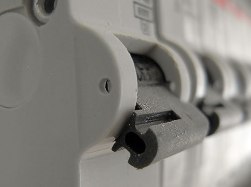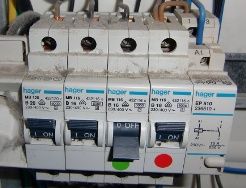Categories: Electrician Secrets, Automata and RCD
Number of views: 88849
Comments on the article: 9
How to replace a circuit breaker in an electrical panel
 What can happen with a circuit breaker? Circuit breakers, like any other technical device, often fail. Among the possible reasons for this may be the systematic actuation of thermal protection and work at the limit of possibilities in general. In addition, there are cases when the device is not able to keep its setting after the first operation of the thermal release (not to be confused with the electromagnetic, that is, instantaneous release!). With such a malfunction, by the way, the machine outwardly will not be any different from its serviceable counterparts.
What can happen with a circuit breaker? Circuit breakers, like any other technical device, often fail. Among the possible reasons for this may be the systematic actuation of thermal protection and work at the limit of possibilities in general. In addition, there are cases when the device is not able to keep its setting after the first operation of the thermal release (not to be confused with the electromagnetic, that is, instantaneous release!). With such a malfunction, by the way, the machine outwardly will not be any different from its serviceable counterparts.
Contact clamps and cases of modular circuit breakers very often burn out with insufficiently reliable electrical contact. Several untwisted conductors of different sections cannot be clamped well enough. There may be a screw defect in the clamping screw that does not allow the connection to be tightened properly. Finally, for aluminum conductors, it is possible to simply weaken the contact over time.
The result in all these cases is the same - a slight dry crackle begins in the contact clamp, heating occurs and, as a result, the contact burns out. Thus, there is even a danger of fire, therefore, the state of the contact terminals of the machines must be constantly monitored.
Well, in the end, it should be noted that the cause of failure of the circuit breaker can be factory defects, which did not prove itself before installing the device, but which became obvious during operation.
Dismantling the circuit breaker
Be that as it may, the repair of circuit breakers is usually not carried out. Their device is relatively complex, and the price is relatively low. Therefore, if the machine fails, it is simply changed.
Despite the fact that in the general case the insulation of conductors in the switchboard is quite reliable, and the terminals of the machines are very simple and easy to handle, it is better to disconnect it before replacing the circuit breaker. For people who are completely ignorant of electrical engineering, we explain: this does not mean “turn off the machine before replacing”, but “disconnect the line that feeds it.”
This is especially true for advanced cases when the pole of the circuit breaker resembles the ashes of a fire. In such a clamp, everything could stick to and weld to each other for a long time, and replacing such a circuit breaker will resemble a surgical operation. Amputation of the charred end of the conductor. It is for such cases, by the way, that the shields are supposed to leave a reserve of wires.
Most of the machines in the dashboard are distribution, or linear - they feed some part of the household network or a separate power receiver. To de-energize such an apparatus, it is enough to turn off the input (most powerful) machine or bag.
It is more difficult when the replacement of the input automaton itself is required, or when there is no input automaton or packet. In such cases, it is impossible to do without the assistance of the electricians of the operating organization, since the voltage can only be removed in the switchgear or other switchgear located outside the apartment and locked in a separate lock.
After disconnection, the absence of voltage must be checked with working indicator or multimeter. After that, disconnect the conductors: cross or flat (universal screws for the machines) with a suitable size screwdriver, try to unscrew the clamps. If it does not work out, which is not uncommon for burnt out machines, then we take side cutters and bite the wires. Having disconnected the conductors, we separate them to the sides and take up the apparatus itself.
 Most machines in modern shields are mounted on an omega-shaped DIN rail. Dismantling and installation of such devices is simple to disgrace. There should be an eyelet at the bottom-back of the machine, into which the middle flat screwdriver easily enters. Multipole and differential automata can have two such eyes.
Most machines in modern shields are mounted on an omega-shaped DIN rail. Dismantling and installation of such devices is simple to disgrace. There should be an eyelet at the bottom-back of the machine, into which the middle flat screwdriver easily enters. Multipole and differential automata can have two such eyes.
These eyes are mechanically connected to the lower grips of the machine. The upper grips are motionless. To remove the machine from the rail, simply insert a screwdriver into the eyelet, slightly pull it down, using a screwdriver as a lever, and remove the lower part. With the second eye, if available, we perform the same operation. When the lower part of the machine becomes free, the upper is easily removed by a simple upward movement, and the device will be in your hand.
Despite the fact that all this is very simple, it is necessary to take into account some nuances. Firstly, all this simple construction is somewhat flattering. Breaking the bottom grip or eye is easy. And if the replaced machine is not particularly pathetic, then it is advisable to save the newly installed one. Therefore, we act very carefully.
The second point is the design features of some of the lower grips. Many of them are simply spring loaded and automatically come back as soon as you take out the screwdriver. This is not very convenient when you are shooting or putting an automatic machine with two eyes: a situation may arise when you need to insert screwdrivers into both eyes at the same time and simultaneously use them. In this case, you have to contrive.
But there are machines in which the lower grip has a latch. Moreover, if you pull the eye down, it will not return to its original position until it is latched by a light push. Such a constructive solution greatly facilitates installation and dismantling.
A few words must be said about the old-style machines with fastening not on the rail, but with long screws located in the lower and upper part of the device. If you encounter such an instance, you can only hope that the screws are not stuck and not rusted. Then they will get out without problems, and you will have a choice: either find and buy the same new machine (they are still on sale), or install a piece of DIN rail on the panel with a pair of self-tapping screws and put a modern modular device.
Mounting circuit breaker
When installing the circuit breaker, the reverse sequence of operations: put the machine with the upper grip on the rail, pull the eyes and put the lower part back in place. We click or release the eyes: the device is in place. Now we revise the ends of the wires, if necessary, cut and strip them and install them in the terminals of the machine.
After that we apply voltage, turn on the machine and look at its “behavior" in work under load. There is no sparking, fusion and other thermal and noise effects, there are no false positives - which means that the replacement was a success.
Of course, the newly installed machine is preferably subjected to laboratory loading before installation. But in practice this is not always achievable. Therefore, we carefully approach the issue of choosing a circuit breaker. By the way, in case of a change in the nominal current and characteristics of the machine, you must be sure that these changes are justified. If you are not sure, then consult with specialists before changing, say, an automatic machine from 16 to 25 amperes for the same line.
Since today it is allowed to install introductory machines to electricity metering devices, from the side of energy sales companies the requirement to seal the contacts of an input switching device is increasingly heard. Changing such a circuit breaker, you must install the device with the ability to seal the contacts, and after replacement you must invite the inspector to put the seal.
Alexander Molokov
See also at i.electricianexp.com
:
